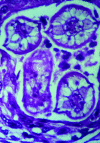Baylisascaris procyonis: an emerging helminthic zoonosis
- PMID: 11971766
- PMCID: PMC2730233
- DOI: 10.3201/eid0804.010273
Baylisascaris procyonis: an emerging helminthic zoonosis
Abstract
Baylisascaris procyonis, a roundworm infection of raccoons, is emerging as an important helminthic zoonosis, principally affecting young children. Raccoons have increasingly become peridomestic animals living in close proximity to human residences. When B. procyonis eggs are ingested by a host other than a raccoon, migration of larvae through tissue, termed larval migrans, ensues. This larval infection can invade the brain and eye, causing severe disease and death. The prevalence of B. procyonis infection in raccoons is often high, and infected animals can shed enormous numbers of eggs in their feces. These eggs can survive in the environment for extended periods of time, and the infectious dose of B. procyonis is relatively low. Therefore, the risk for human exposure and infection may be greater than is currently recognized.
Figures


References
-
- Kazacos KR, Boyce WM. Baylisascaris larva migrans. J Am Vet Med Assoc. 1989;195:894–903. - PubMed
-
- Hamann KJ, Kephart GM, Kazacos KR, Gleich GJ. Immunofluorescent localization of eosinophil granule major basic protein in fatal human cases of Baylisascaris procyonis infection. Am J Trop Med Hyg. 1989;40:291–7. - PubMed
